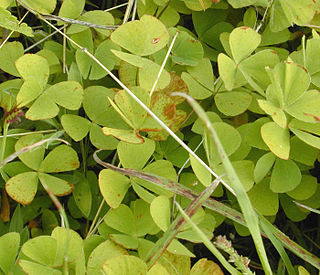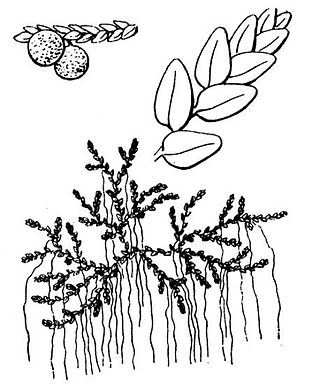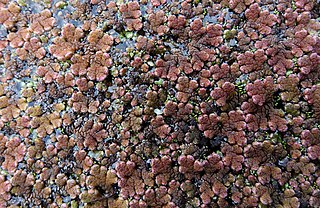
A fern is a member of a group of vascular plants that reproduce via spores and have neither seeds nor flowers. The polypodiophytes include all living pteridophytes except the lycopods, and differ from mosses and other bryophytes by being vascular, i.e., having specialized tissues that conduct water and nutrients and in having life cycles in which the branched sporophyte is the dominant phase.

Azolla is a genus of seven species of aquatic ferns in the family Salviniaceae. They are extremely reduced in form and specialized, looking nothing like other typical ferns but more resembling duckweed or some mosses. Azolla filiculoides is one of just two fern species for which a reference genome has been published. It is believed that this genus grew so prolifically during the Eocene that it triggered a global cooling event that has lasted to the present.

The order Salviniales is an order of ferns in the class Polypodiopsida.

Salvinia, a genus in the family Salviniaceae, is a floating fern named in honor of Anton Maria Salvini, a 17th-century Italian scientist. Watermoss is a common name for Salvinia. The genus was published in 1754 by Jean-François Séguier, in his description of the plants found round Verona, Plantae Veronenses Twelve species are recognized, at least three of which are believed to be hybrids, in part because their sporangia are found to be empty.

Salviniaceae, is a family of heterosporous ferns in the order Salviniales. The Salviniaceae contain the two genera Azolla and Salvinia, with about 20 known species in total. The oldest records of the family date to the Late Cretaceous. Azolla was previously placed in its own family, Azollaceae, but research has shown Azolla and Salvinia to be sister genera with the likely phylogenic relationship shown in the following diagram.

The Canning River is a major tributary of the Swan River in the South West Land Division of Western Australia. It is home to much wildlife including dolphins, pelicans, swans and many other bird species.

The North Somerset Levels is a coastal plain, an expanse of low-lying flat ground, which occupies an area between Weston-super-Mare and Bristol in North Somerset, England. The River Banwell, River Kenn, River Yeo and Land Yeo are the three principal rivers draining the area.

Azolla filiculoides is a species of Azolla, native to warm temperate and tropical regions of the Americas which was introduced to Europe, North and sub-Saharan Africa, China, Japan, New Zealand, Australia, the Caribbean and Hawaii.

Spilomelinae is a very species-rich subfamily of the lepidopteran family Crambidae, the crambid snout moths. With 4,135 described species in 344 genera worldwide, it is the most speciose group among pyraloids.

Azolla cristata , the Carolina mosquitofern, Carolina azolla or water velvet, is a species of Azolla native to the Americas, in eastern North America from southern Ontario southward, and from the east coast west to Wisconsin and Texas, and in the Caribbean, and in Central and South America from southeastern Mexico (Chiapas) south to northern Argentina and Uruguay.

Anzali Lagoon is a coastal liman, or lagoon, in the Caspian Sea near Bandar-e Anzali, in the northern Iranian province of Gilan. The lagoon divides Bandar-e Anzali into two parts, and is home to both the Selke Wildlife Refuge and the Siahkesheem Marsh.

Cataclysta lemnata, the small china-mark, is a moth species of the family Crambidae. It is found in Europe, Morocco and Iran.

Diasemiopsis is a genus of moths of the family Crambidae.

Azolla primaeva is an extinct species of "water fern" in the family Salviniaceae known from Eocene fossils from the Ypresian stage, found in southern British Columbia.

Azolla pinnata is a species of fern known by several common names, including mosquitofern, feathered mosquitofern and water velvet. It is native to much of Africa, Asia and parts of Australia. It is an aquatic plant, it is found floating upon the surface of the water. It grows in quiet and slow-moving water bodies because swift currents and waves break up the plant. At maximum growth rate, it can double its biomass in 1.9 days, with most strains attaining such growth within a week under optimal conditions.

Samea multiplicalis, the salvinia stem-borer moth, is an aquatic moth commonly found in freshwater habitats from the southern United States to Argentina, as well as in Australia where it was introduced in 1981. Salvinia stem-borer moths lay their eggs on water plants like Azolla caroliniana, Pistia stratiotes, and Salvinia rotundifolia. Larval feeding on host plants causes plant death, which makes S. multiplicalis a good candidate for biological control of weedy water plants like Salvinia molesta, an invasive water fern in Australia. However, high rates of parasitism in the moth compromise its ability to effectively control water weeds. S. multiplicalis larvae are a pale yellow to green color, and adults develop tan coloration with darker patterning. The lifespan, from egg to the end of adulthood is typically three to four weeks. The species was first described by Achille Guenée in 1854.

Azolla mexicana, the Mexican mosquito fern, is an aquatic fern native to Mexico, British Columbia and the western United States.

Azolla rubra, known commonly as red azolla and Pacific azolla is a species of fern native to Australia and New Zealand. In New Zealand, it may also be known by its Māori names returetu, roturotu, kārearea and kārerarera.

















